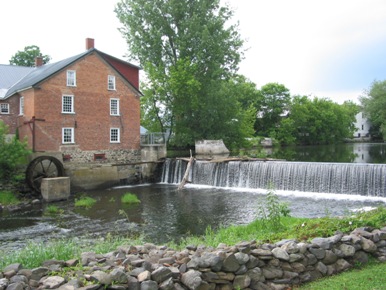 MUSEUM IN A MILL
MUSEUM IN A MILL
Missisquoi Museum in Stanbridge East is a highlight on any trip to Missisquoi County. The museum is housed in the historic Cornell Mill at the centre of the village and is spread out over several different levels of the sprawling old structure. Built entirely of the brick and fieldstone so typical of Missisquoi County, the building hugs the bank of the Pike River just as it has since it was built back in 1830.
The walls of the place are leaning and cracked in several spots, and patches to the brick and mortar show where repairs have been carried out at different times in the building's long history. On the side of the mill overlooking the river and dam, a waterwheel still turns leisurely. It is summer, and the current in the stream is not very fast.
Inside the museum, there is the scent of old wood - not surprising for a mill of this vintage. Indeed, a museum in a mill poses its own unique challenges for the professionals who run it. A couple of years ago, during spring, the river flooded its banks and seeped into the lower levels of the building. A beaver made itself at home down there, amidst the old mill's post and beam underpinnings.
Displaying the laid-back attitude that so many visitors to Stanbridge East find charming, museum curator Heather Darch chuckles about the incident. "We opened up the trap door to the basement one morning, and much to our surprise, there was this huge brown-eyed beaver squatting on a mill stone - just sitting there as bold as can be - looking up at us." With a grin Darch adds, "Then we started to wonder what he was going to eat down there!" Fortunately after a day or two the uninvited guest moseyed out the way he came, presumably through some crack somewhere.
 THE ARTIFACTS COME FIRST
THE ARTIFACTS COME FIRST
For all its quirks, Missisquoi Museum manages to achieve a remarkable degree of professionalism. For example, a visit to the administrative annex on the west side of the mill reveals the conscientious and systematic fashion in which the institution is run by its skeleton staff and its volunteer board of directors. Humidity and other environmental controls and acid-free storage equipment are in evidence everywhere. And everything from stiff top hats to cheery porcelain-faced dolls await careful classification and storage in as neutral an environment as possible.
For sure things are a bit on the cramped side for staffers here in this behind-the-scenes corner of the museum, but everyone who works here knows that the artifacts come first. Darch takes it all in stride: "I have four people in my tiny little office. I have to step over a fan and a box to get out the door." But the public side of Missisquoi Museum is spacious enough, and that is what counts to most visitors. And clearly Darch and her staff love the museum and its collections, and take very seriously their responsibility as caretakers of the region's history.
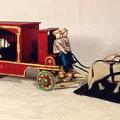 SINCE 1899
SINCE 1899
In the Cornell Mill since 1964 (a bronze plaque marks the occasion of the transfer), the Missisquoi Historical Society that runs the museum was founded in 1899. One of the oldest historical societies in the Eastern Townships, the Society's mission is straightforward: to preserve and promote the history of this part of the Townships, with special emphasis on the area's United Empire Loyalist roots.
PRIZED REDCOAT
Visitors will discover some of the most treasured objects from Missisquoi's past on the various floors of the mill. One artifact, particularly prized, is the redcoat worn by pioneer Hendrick TenEyck during the American Revolution to escape being pressed into the British Navy. Another treasure is the flag of the Missisquoi "Home Guards" who defended the Canadian Border against the Fenians at the battle of Eccles Hill in 1870. That was the last time the country was invaded!
An especially charming display is the collection of 500 hand-carved and intricately painted wooden miniatures of a traveling circus, lovingly crafted by husband and wife Charles and Florence Millard back in the 1920s. Mr. Millard was a Canadian Customs inspector who was struck by inspiration one day when he witnessed the Barnum and Bailey Circus crossing into Canada at the Sutton border. The result was a masterpiece of folk art that is still a delight to visitors both young and old.
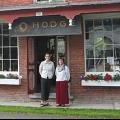 HODGE'S STORE
HODGE'S STORE
Missisquoi Museum is actually three sites in one. Just a stone's throw up River Street is Hodge's Store. Built c.1840, this unusual little red brick building operated as a general store for three generations. According to historian and local resident Brian Young, "Hodge refused to sell cigarettes, but did stock chewing tobacco and had well placed spittoons for loungers around the store."
The store also served as a pharmacy, post office, and most certainly as the village gossip-mill. Hodge's closed in 1972, and the family deeded the building and all of its contents to the historical society, on the condition that the store be kept just as it was.
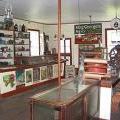 Hodge's Store is so authentic that it seems as if the storekeeper just stepped outside for a moment. But the funny thing about the place is that much of the stock on the shelves dates back to the Second World War and some of it as far back as the turn of the last century. Clearly the merchandise here did not fly off the shelves! In fact, there are still stacks of calendars dating to the 1940s, and the postcards on the racks are the same ones that were for sale over half a century ago!
Hodge's Store is so authentic that it seems as if the storekeeper just stepped outside for a moment. But the funny thing about the place is that much of the stock on the shelves dates back to the Second World War and some of it as far back as the turn of the last century. Clearly the merchandise here did not fly off the shelves! In fact, there are still stacks of calendars dating to the 1940s, and the postcards on the racks are the same ones that were for sale over half a century ago!
Guides from the Museum are happy to accompany visitors to Hodge's, and to let them "browse" amidst the advertisements for dry goods and the tins of groceries and coffee that still line the shelves. What a fun place! Another site run by the Museum is Bill's Barn, further up the street. Bill's houses a fascinating collection of agricultural artifacts from years past.
STANBRIDGE EAST: A STROLL INTO THE PAST
Strolling up and down the streets of Stanbridge East, one is struck by the fact that nothing seems to have changed much here in the last century or so. Blinn's, built in 1898, is a rambling clapboard store on River Street not far from the mill. Its shelves still stock hardware and other day-to-day articles homeowners need.
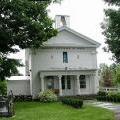 At other spots along the street one can see the homes that until not so long ago housed a harness maker, a barber shop, a shoemaker, and other tradesmen. Across the street from the mill is the former Baker-Gilmour Bank, an imposing neo-classical edifice built in 1861, which was converted to a Catholic church fifty years ago when a local bank was no longer needed. Now a restaurant, the façade and porch of the building are dominated by towering Ionic columns, the classical symbols of order.
At other spots along the street one can see the homes that until not so long ago housed a harness maker, a barber shop, a shoemaker, and other tradesmen. Across the street from the mill is the former Baker-Gilmour Bank, an imposing neo-classical edifice built in 1861, which was converted to a Catholic church fifty years ago when a local bank was no longer needed. Now a restaurant, the façade and porch of the building are dominated by towering Ionic columns, the classical symbols of order.
Large maple trees line the sleepy village streets. Here and there are brick and clapboard homes that date back nearly two centuries. Across the river from the mill is the former Cecil Hotel, built back in 1849 and dispensing spirituous liquors to this day. By the bridge on Caleb Street is the Palmer House (1847), an unusual home with squared gables and made of local red bricks. It is said that this style was imported by the early settlers whose own ancestors came from Holland.
Bypassed by the highway, in many ways Stanbridge East seems bypassed by time, as well. The village is quite justly considered one of prettiest in the Townships, and is well worth a visit.